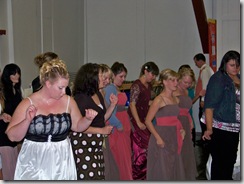[this is a version of a post which first appeared on my blog From the Front of the Choir]
From my experience with choirs and singing groups it appears that we are a rhythmically challenged nation.

I often try to introduce a bit of clapping or some steps into our warm-ups and songs and am always amazed at the apparent lack of co-ordination and body-awareness amongst the group.
As soon as I begin teaching simple dance steps, or a simple clapping rhythm (especially one that is not on the beat), several people just sit out and don’t even bother to try because they ‘know’ they can’t do it. And some people sit out because “I’ve come here to sing, not dance!”
Of course, everyone does have a sense of rhythm, it’s just that we don’t practice it very often. So people give up too quickly thinking they can’t do it. Rather like people who think they can’t ‘sing’ because they can’t immediately pick up a tune – they are simply out of practice with their listening skills.
It seems to me that this is a cultural phenomenon. Our culture has become very visual and rational. We use our eyes and thinking brains far more than our ears and bodies.
Once people have sung in a choir for some time, they get in contact again with their innate listening abilities. They learn to trust their ears and not just their eyes. Similarly, given time and patience, I believe that people can re-discover their innate sense of rhythm and body-awareness.
In our culture we tend to compartmentalise different activities. For example, when we’re singing, we’re singing – we’re not dancing. We think we don’t need to pay any attention to our bodies. Similarly, when we’re dancing or clapping, we think we don’t need our voices.
I came across this time and time again when I taught at drama school. The lessons themselves were even compartmentalised: a movement class followed by a voice class followed by a tap class. When I arrived and tried to teach everything at the same time, there were a lot of confused students!
In many other cultures – notably African cultures – there is very little, if any, separation between dance, vocal melody and rhythm. You only have to see a group of South Africans, for instance, singing a song and you cannot see where the dance ends and the song begins – it is all the same thing.
So when learning songs from these cultures, we often find it difficult. It is no good trying to count some complex off-beat rhythm in your head using your conscious brain, it’s just too hard. You have to let your body ‘dance’ the rhythm and then the song’s timing will come automatically. Similarly with the complex 7/8 rhythms common in the Balkans – just learn the dance at the same time and it comes easy!
Sometimes we find ourselves carrying out a complex task such as patting our head whilst rubbing our tummy and find that sweet moment when it all falls into place. But then as soon as we begin to think (“Great, it’s working” or “I hope I’m getting it right”) it all goes disastrously wrong! We need to trust our intuition, our body intelligence, our non-rational brain which is just getting on with the task quite nicely thank you.
The Natural Voice approach to singing (which I follow) places the relationship between breath, body and voice at its heart. We believe that you simply can’t separate these components to be fully in the song. And it’s no coincidence that much of our repertoire comes from cultures which don’t make these separations.
I once met an instrumentalist who wouldn’t even begin to play tunes from another culture until she’d been to a few dance classes from that culture. She needed to embed the culture’s ‘dance’ into her body before she even picked up her instrument.
A few years back I was taught an amazing Ysaye Barnwell gospel-like song called Lawd it’s midnight (from LESSONS An a cappella suite of songs for mixed chorus, 1993).
This is an amazing song with some quite tricky rhythms. We learnt it by having the sheet music in our hands and it took a long time to get it right. Most of the difficulties were to do with the cross rhythms.
It occurred to me afterwards that we probably would have learnt it a lot faster if we had put the music down and simply let the rhythms into our bodies!
It’s far easier to learn a movement or clapping sequence at the same time as learning the associated song. In the same way as learning lyrics whilst singing, it is stored in a different part of the brain. If you try to learn everything separately, it will be much, much harder.
A few years ago I tried an experiment which involved teaching a movement sequence at the same time as I taught a new song (Dancing the song). The movements had no connection with the meaning of the song, but I wanted to see if it helped people learn more quickly. It was a big success, and even years later when we revived the song, everyone remembered the movements! If I had asked people to just sing the song or just do the movements, I don’t think they would have been able to.
So next time somebody asks you to move or dance at the same time as you're singing, they're not trying to make life difficult for you, they're actually making it easier for you to learn the song. Just go with it!
Chris Rowbury
website: chrisrowbury.com
blog: blog.chrisrowbury.com
Facebook: Facebook.com/ChrisRowbury
Twitter: Twitter.com/ChrisRowbury